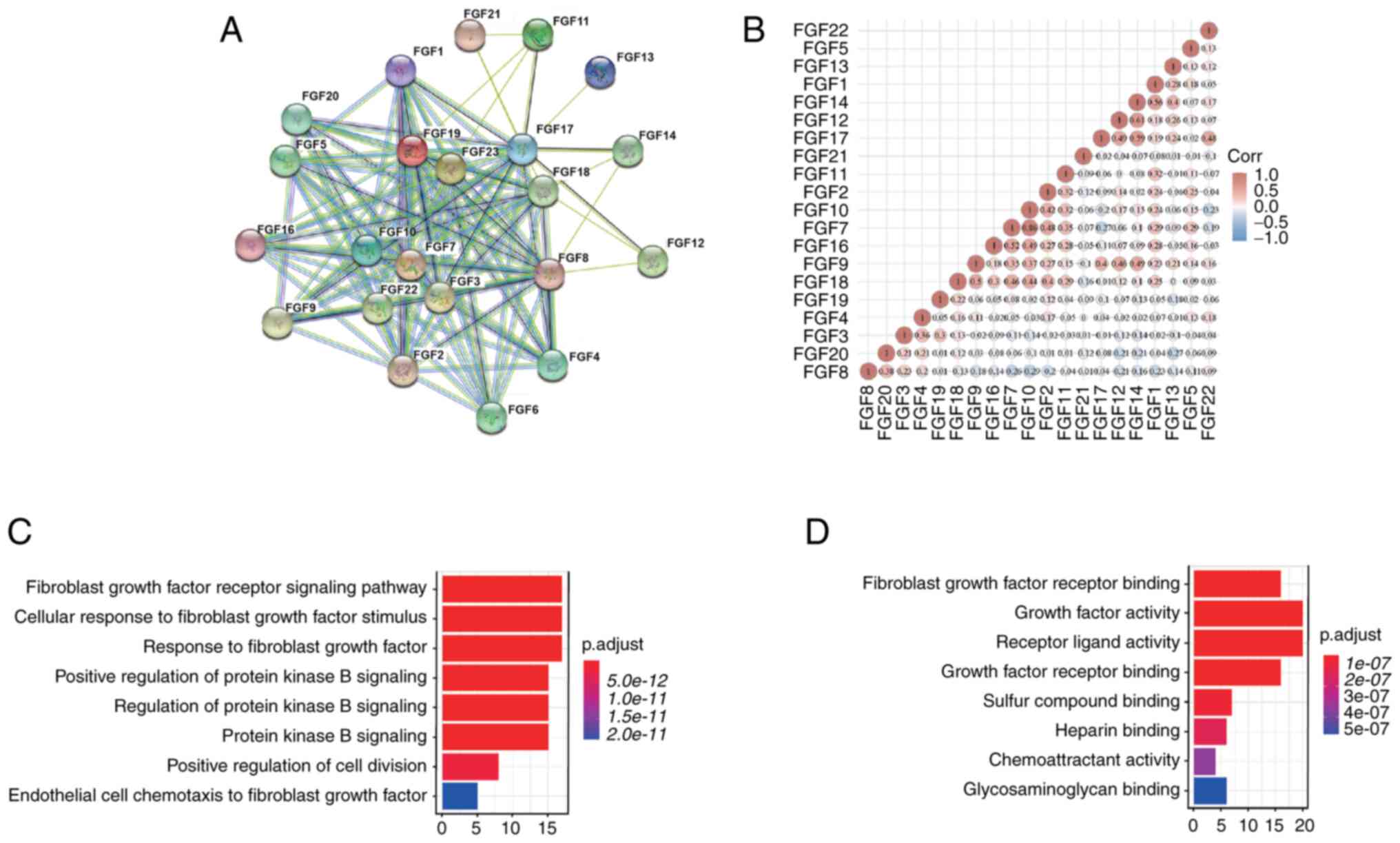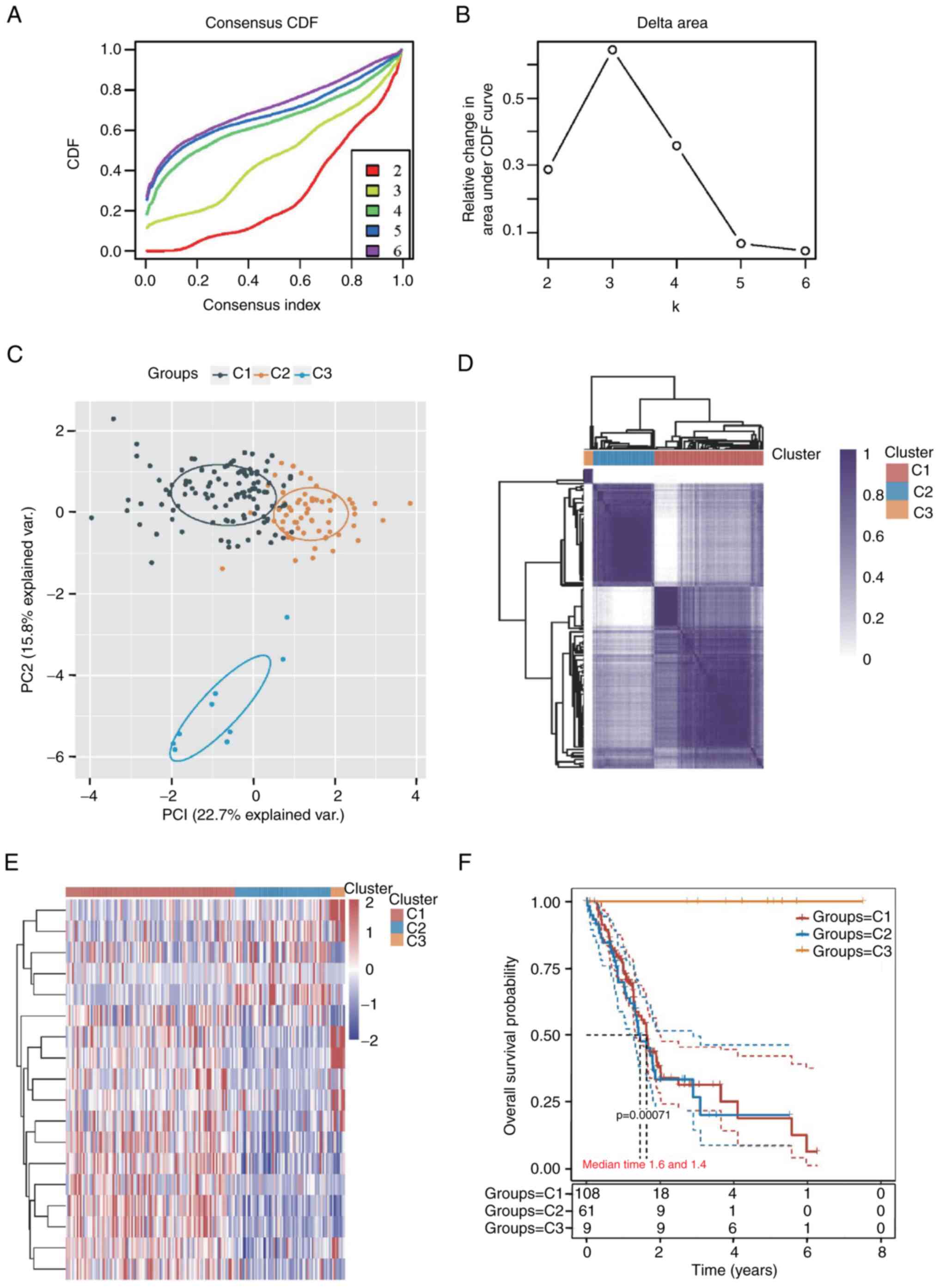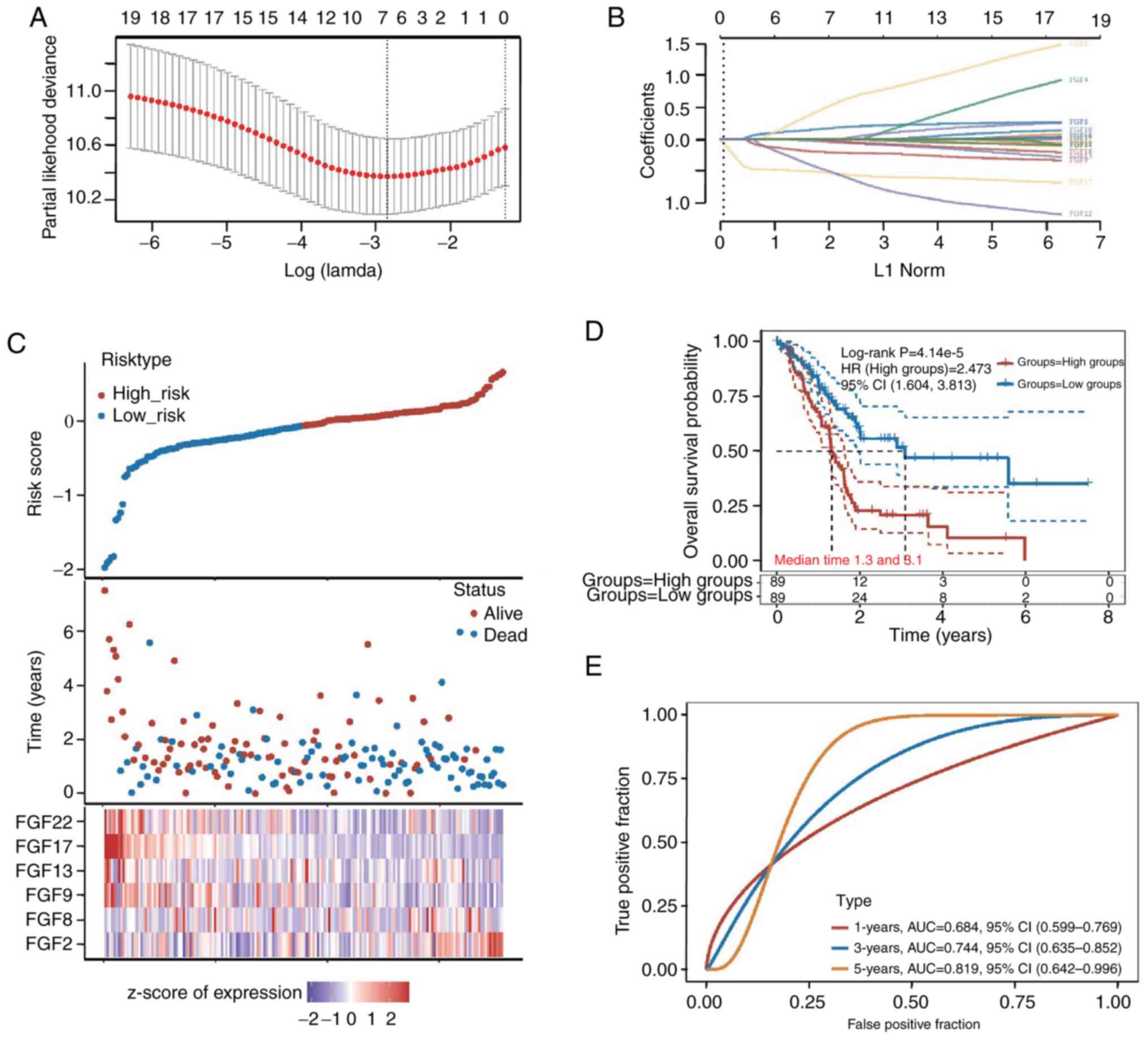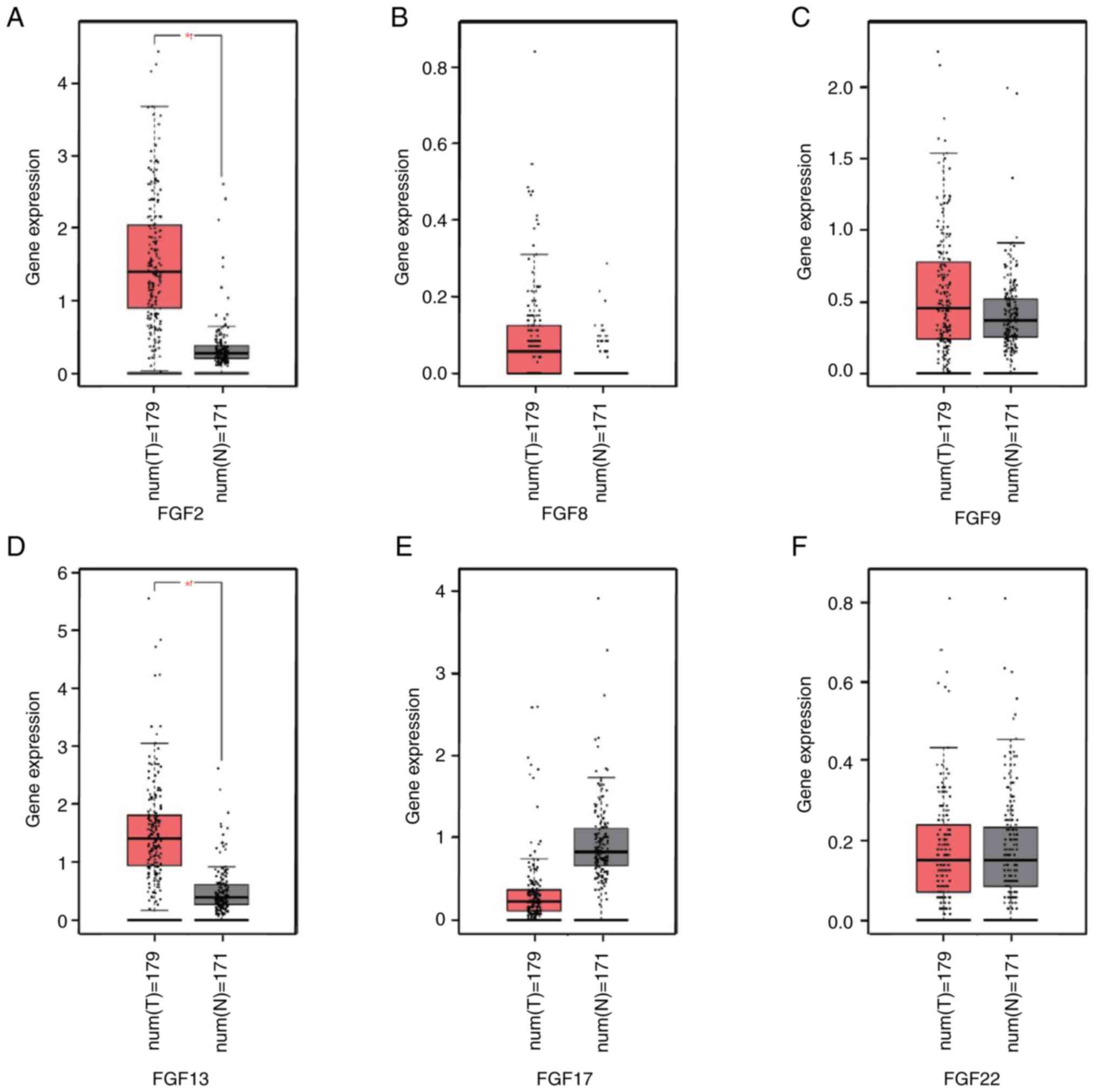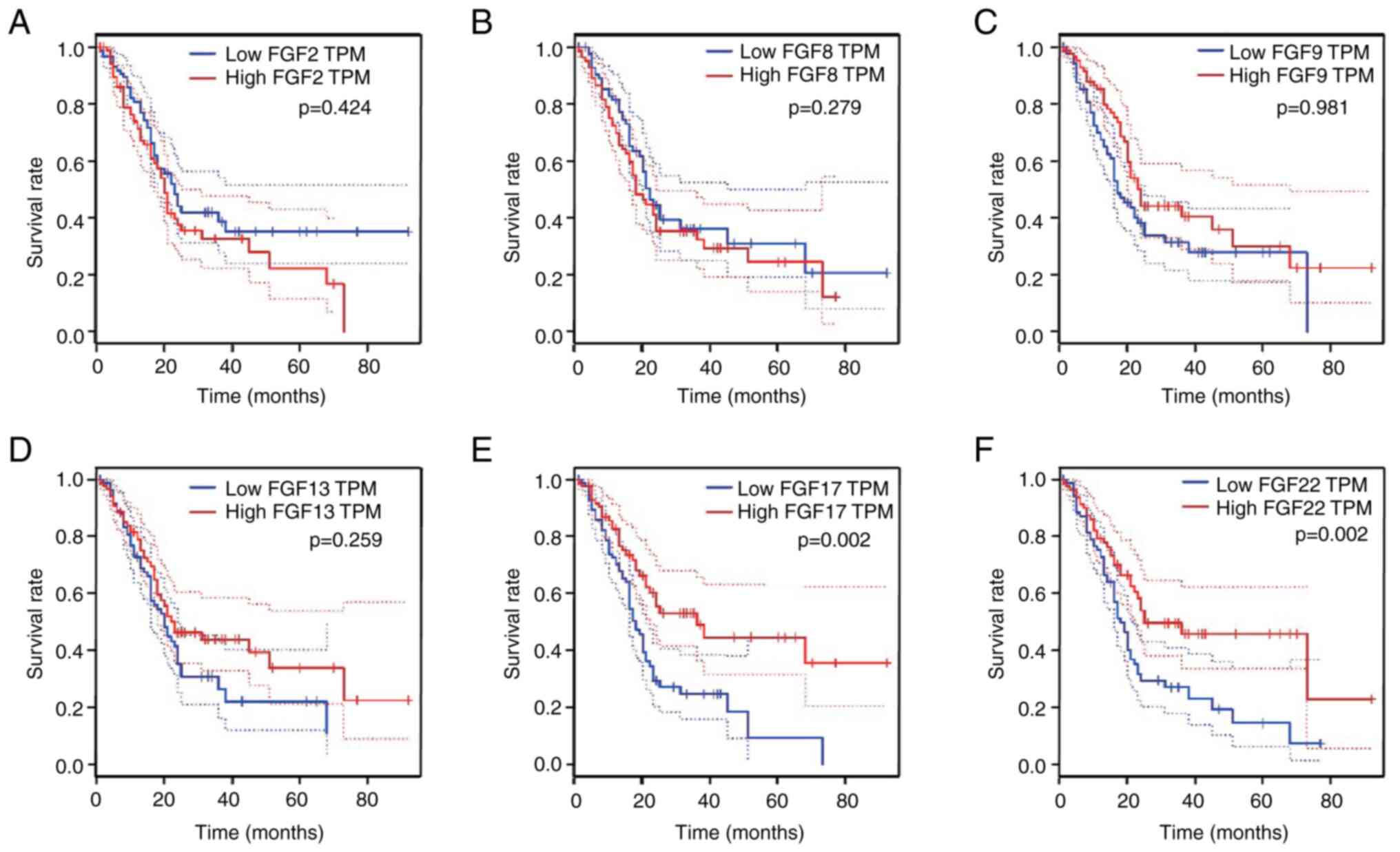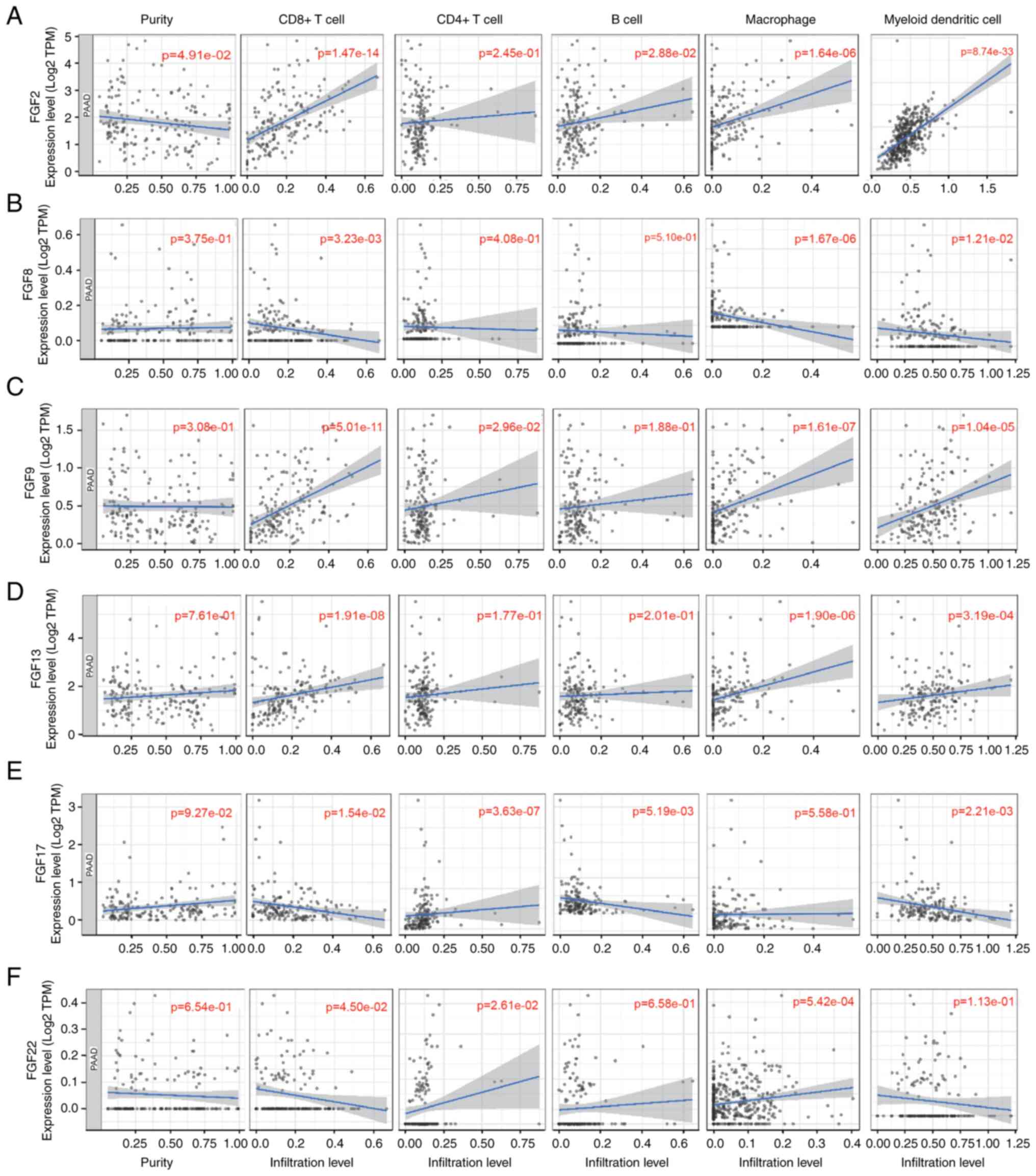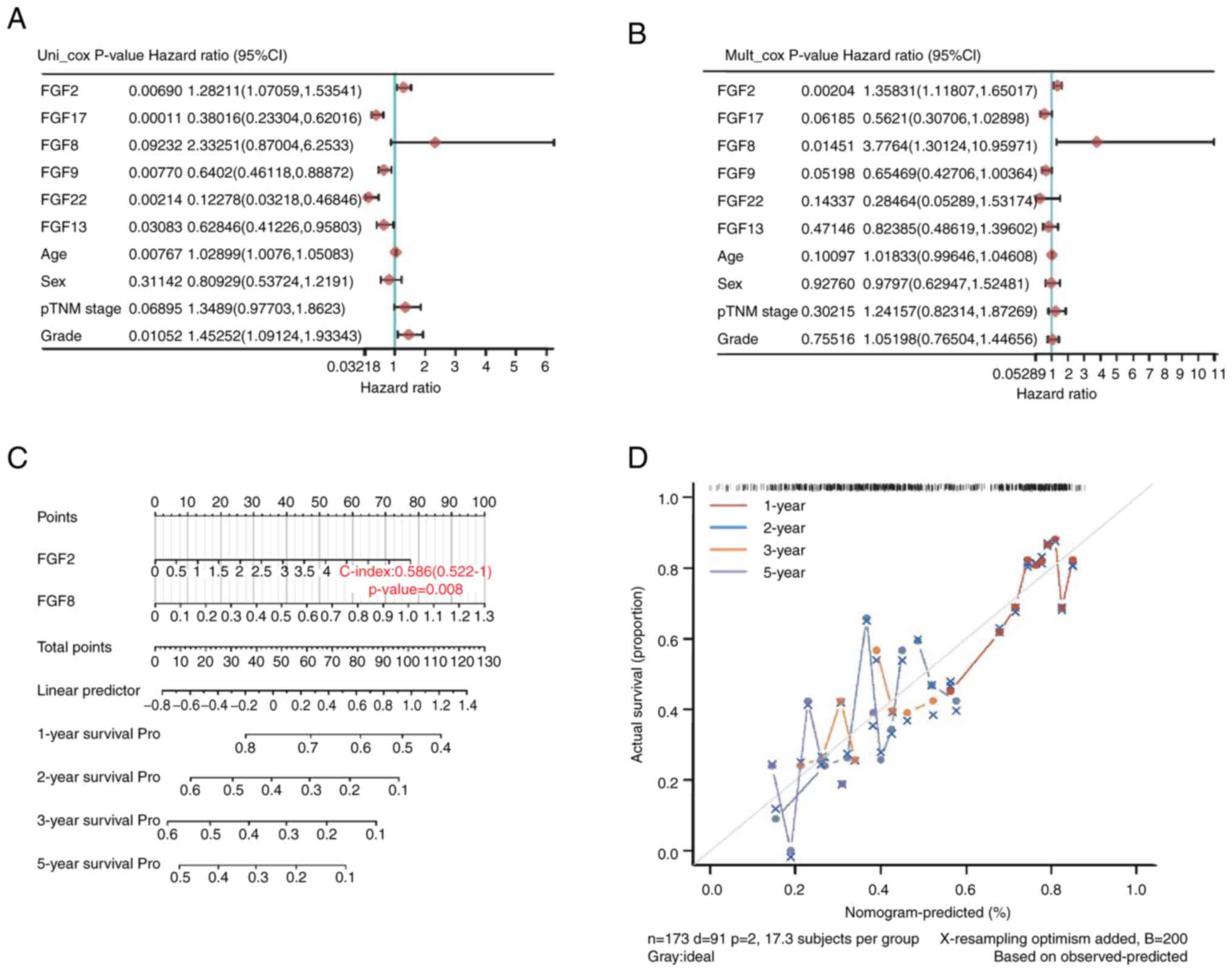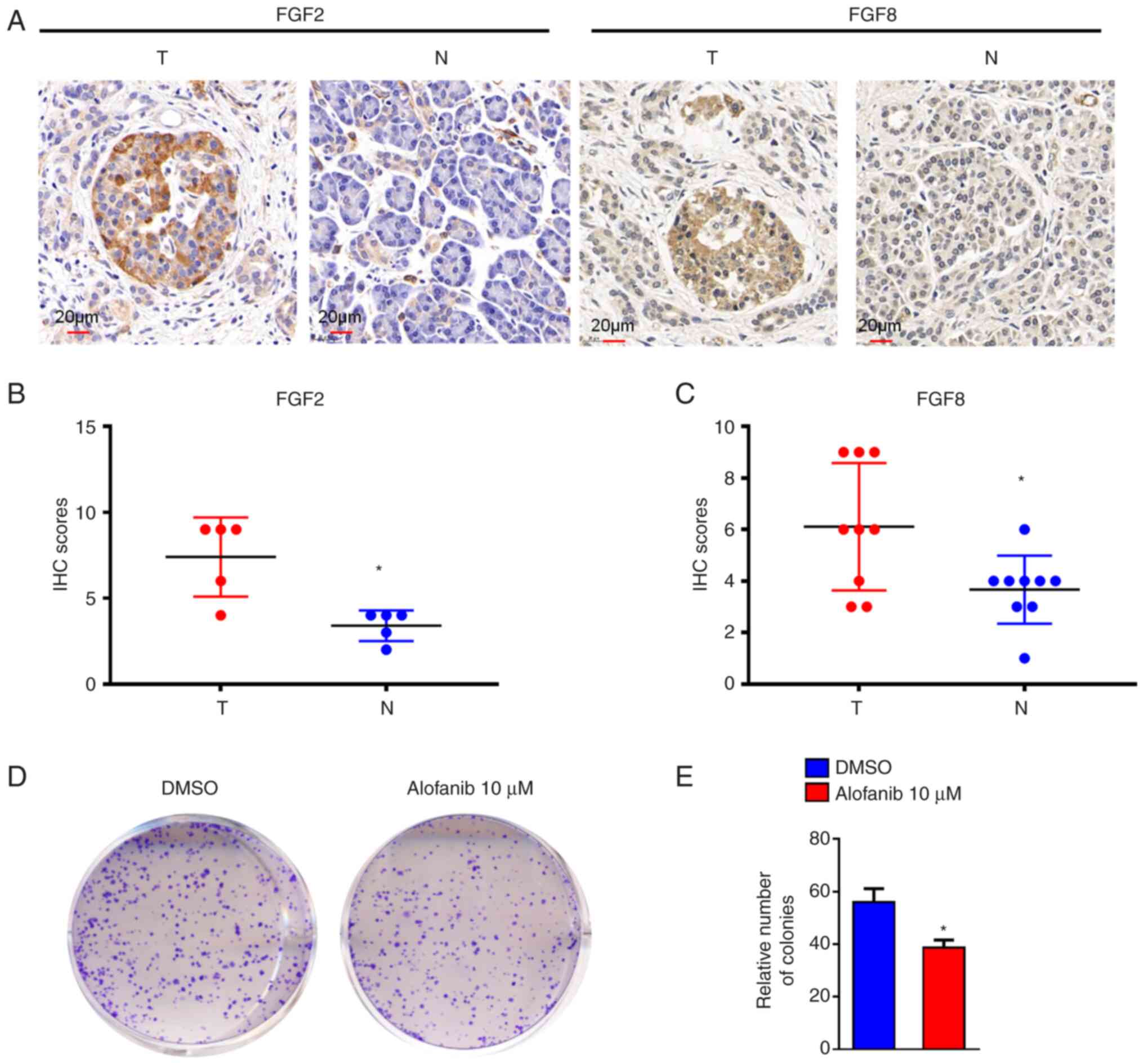|
1
|
Sung H, Ferlay J, Siegel RL, Laversanne M,
Soerjomataram I, Jemal A and Bray F: Global cancer statistics 2020:
GLOBOCAN estimates of incidence and mortality worldwide for 36
cancers in 185 countries. CA Cancer J Clin. 71:209–249. 2021.
View Article : Google Scholar : PubMed/NCBI
|
|
2
|
Siegel RL, Miller KD and Jemal A: Cancer
statistics, 2019. CA Cancer J Clin. 69:7–34. 2019. View Article : Google Scholar : PubMed/NCBI
|
|
3
|
Fukushima G, Abe K, Kitago M, Iwasaki E,
Hirata A, Takemura R, Ishii R, Yagi H, Abe Y, Hasegawa Y, et al:
Association between clinical backgrounds and malignant progression
of suspected intraductal papillary mucinous neoplasm. Pancreas.
51:617–623. 2022. View Article : Google Scholar : PubMed/NCBI
|
|
4
|
Brugel M, Carlier C, Reyes-Castellanos G,
Callon S, Carrier A and Bouche O: Pesticides and pancreatic
adenocarcinoma: A transversal epidemiological, environmental and
mechanistic narrative review. Dig Liver Dis. 8:S1590–S8658.
2022.
|
|
5
|
Okita Y, Sobue T, Zha L, Kitamura T,
Iwasaki M, Inoue M, Yamaji T, Tsugane S and Sawada N: Association
between alcohol consumption and risk of pancreatic cancer: The
japan public health center-based prospective study. Cancer
Epidemiol Biomark Prev. 3:EPI22–0216. 2022.
|
|
6
|
Irisawa A, Takeno M, Watanabe K, Takahashi
H, Mitsunaga S and Ikeda M: Incidence of and risk factors for
severe neutropenia during treatment with the modified FOLFIRINOX
therapy in patients with advanced pancreatic cancer. Sci Rep.
12:155742022. View Article : Google Scholar : PubMed/NCBI
|
|
7
|
Molinelli S, Vai A, Russo S, Loap P,
Meschini G, Paganelli C, Barcellini A, Vitolo V, Orlandi E and
Ciocca M: The role of multiple anatomical scenarios in plan
optimization for carbon ion radiotherapy of pancreatic cancer.
Radiother Oncol. 176:1–8. 2022. View Article : Google Scholar : PubMed/NCBI
|
|
8
|
Alshememry AK, Alsaleh NB, Alkhudair N,
Alzhrani R and Alshamsan A: Recent nanotechnology advancements to
treat multidrug-resistance pancreatic cancer: Pre-clinical and
clinical overview. Front Pharmacol. 13:9334572022. View Article : Google Scholar : PubMed/NCBI
|
|
9
|
Gautam SK, Basu S, Aithal A, Dwivedi NV,
Gulati M and Jain M: Regulation of pancreatic cancer therapy
resistance by chemokines. Semin Cancer Biol. 86:69–80. 2022.
View Article : Google Scholar : PubMed/NCBI
|
|
10
|
Kang X, Lin Z, Xu M, Pan J and Wang ZW:
Deciphering role of FGFR signalling pathway in pancreatic cancer.
Cell Prolif. 52:e126052019. View Article : Google Scholar : PubMed/NCBI
|
|
11
|
Thomas D and Radhakrishnan P:
Tumor-stromal crosstalk in pancreatic cancer and tissue fibrosis.
Mol Cancer. 18:142019. View Article : Google Scholar : PubMed/NCBI
|
|
12
|
Zhang Z, Qin Y, Ji S, Xu W, Liu M, Hu Q,
Ye Z, Fan G, Yu X, Liu W and Xu X: FGFBP1-mediated crosstalk
between fibroblasts and pancreatic cancer cells via FGF22/FGFR2
promotes invasion and metastasis of pancreatic cancer. Acta Biochim
Biophys Sin(Shanghai). 53:997–1008. 2021.PubMed/NCBI
|
|
13
|
El-Hariry I, Pignatelli M and Lemoine NR:
FGF-1 and FGF-2 regulate the expression of E-cadherin and catenins
in pancreatic adenocarcinoma. Int J Cancer. 94:652–661. 2001.
View Article : Google Scholar : PubMed/NCBI
|
|
14
|
Pecqueux C, Arslan A, Heller M,
Falkenstein M, Kaczorowski A, Tolstov Y, Sültmann H, Grüllich C,
Herpel E, Duensing A, et al: FGF-2 is a driving force for
chromosomal instability and a stromal factor associated with
adverse clinico-pathological features in prostate cancer. Urol
Oncol. 36:365–e315. 365–e326. 2018. View Article : Google Scholar : PubMed/NCBI
|
|
15
|
Sun C, Tian X, Jia Y, Yang M, Li Y and
Fernig DG: Functions of exogenous FGF signals in regulation of
fibroblast to myofibroblast differentiation and extracellular
matrix protein expression. Open Biol. 12:2103562022. View Article : Google Scholar : PubMed/NCBI
|
|
16
|
Belov AA and Mohammadi M: Molecular
mechanisms of fibroblast growth factor signaling in physiology and
pathology. Cold Spring Harb Perspect Biol. 5:a0159582013.
View Article : Google Scholar : PubMed/NCBI
|
|
17
|
Bock FJ, Sedov E, Koren E, Koessinger AL,
Cloix C, Zerbst D, Athineos D, Anand J, Campbell KJ, Blyth K, et
al: Apoptotic stress-induced FGF signalling promotes non-cell
autonomous resistance to cell death. Nat Commun. 12:65722021.
View Article : Google Scholar : PubMed/NCBI
|
|
18
|
Guo K, Ma Z, Zhang Y, Han L, Shao C, Feng
Y, Gao F, Di S, Zhang Z, Zhang J, et al: HDAC7 promotes NSCLC
proliferation and metastasis via stabilization by deubiquitinase
USP10 and activation of beta-catenin-FGF18 pathway. J Exp Clin
Cancer Res. 41:912022. View Article : Google Scholar : PubMed/NCBI
|
|
19
|
Xu Z, Cai Y, Liu W, Kang F, He Q, Hong Q,
Zhang W, Li J, Yan Y and Peng J: Downregulated exosome-associated
gene FGF9 as a novel diagnostic and prognostic target for ovarian
cancer and its underlying roles in immune regulation. Aging (Albany
NY). 14:1822–1835. 2022. View Article : Google Scholar : PubMed/NCBI
|
|
20
|
Carter EP, Coetzee AS, Bort ET, Wang Q,
Kocher HM and Grose RP: Dissecting FGF signalling to target
cellular crosstalk in pancreatic cancer. Cells. 10:8472021.
View Article : Google Scholar : PubMed/NCBI
|
|
21
|
Peng J, Sridhar S, Siefker-Radtke AO,
Selvarajah S and Jiang DM: Targeting the FGFR pathway in urothelial
carcinoma: The future is now. Curr Treat Options Oncol.
23:1269–1287. 2022. View Article : Google Scholar : PubMed/NCBI
|
|
22
|
Ohtsu A, Arai S, Sawada T, Kato M, Maeno
Y, Miyazawa Y, Fujizuka Y, Sekine Y, Koike H, Matsui H and Suzuki
K: Fibroblast growth factor receptor inhibitor erdafitinib promotes
Mcl-1 degradation and synergistically induces apoptosis with
Bcl-xL/Bcl-2 inhibitor in urothelial cancer cells. Biochem Biophys
Res Commun. 628:76–83. 2022. View Article : Google Scholar : PubMed/NCBI
|
|
23
|
Wu Y, Yi Z, Li J, Wei Y, Feng R, Liu J,
Huang J, Chen Y, Wang X, Sun J, et al: FGFR blockade boosts T cell
infiltration into triple-negative breast cancer by regulating
cancer-associated fibroblasts. Theranostics. 12:4564–4580. 2022.
View Article : Google Scholar : PubMed/NCBI
|
|
24
|
Karajannis MA, Vincent L, Direnzo R,
Shmelkov SV, Zhang F, Feldman EJ, Bohlen P, Zhu Z, Sun H, Kussie P
and Rafii S: Activation of FGFR1beta signaling pathway promotes
survival, migration and resistance to chemotherapy in acute myeloid
leukemia cells. Leukemia. 20:979–986. 2006. View Article : Google Scholar : PubMed/NCBI
|
|
25
|
Xie Y, Su N, Yang J, Tan Q, Huang S, Jin
M, Ni Z, Zhang B, Zhang D, Luo F, et al: FGF/FGFR signaling in
health and disease. Signal Transduct Target Ther. 5:1812020.
View Article : Google Scholar : PubMed/NCBI
|
|
26
|
Tyulyandina A, Harrison D, Yin W,
Stepanova E, Kochenkov D, Solomko E, Peretolchina N, Daeyaert F,
Joos JB, Aken KV, et al: Alofanib, an allosteric FGFR2 inhibitor,
has potent effects on ovarian cancer growth in preclinical studies.
Invest New Drugs. 35:127–133. 2017. View Article : Google Scholar : PubMed/NCBI
|
|
27
|
Gillen S, Schuster T, Büschenfelde CM,
Friess H and Kleeff J: Preoperative/neoadjuvant therapy in
pancreatic cancer: A systematic review and meta-analysis of
response and resection percentages. PLoS Med. 7:e10002672010.
View Article : Google Scholar : PubMed/NCBI
|
|
28
|
Zhu H, Wei M, Xu J, Hua J, Liang C, Meng
Q, Zhang Y, Liu J, Zhang B, Yu X and Shi S: PARP inhibitors in
pancreatic cancer: Molecular mechanisms and clinical applications.
Mol Cancer. 19:492020. View Article : Google Scholar : PubMed/NCBI
|
|
29
|
Biankin AV, Waddell N, Kassahn KS, Gingras
MC, Muthuswamy LB, Johns AL, Miller DK, Wilson PJ, Patch AM, Wu J,
et al: Pancreatic cancer genomes reveal aberrations in axon
guidance pathway genes. Nature. 491:399–405. 2012. View Article : Google Scholar : PubMed/NCBI
|
|
30
|
Singhi AD, George B, Greenbowe JR, Chung
J, Suh J, Maitra A, Klempner SJ, Hendifar A, Milind JM, Golan T, et
al: Real-time targeted genome profile analysis of pancreatic ductal
adenocarcinomas identifies genetic alterations that might be
targeted with existing drugs or used as biomarkers.
Gastroenterology. 156:2242–2253.e2244. 2019. View Article : Google Scholar : PubMed/NCBI
|
|
31
|
Wang S, Zheng Y, Yang F, Zhu L, Zhu XQ,
Wang ZF, Wu XL, Zhou CH, Yan JY, Hu BY, et al: The molecular
biology of pancreatic adenocarcinoma: Translational challenges and
clinical perspectives. Signal Transduct Target Ther. 6:2492021.
View Article : Google Scholar : PubMed/NCBI
|
|
32
|
Luong T, Golivi Y, Nagaraju GP and
El-Rayes BF: Fibroblast heterogeneity in pancreatic ductal
adenocarcinoma: Perspectives in immunotherapy. Cytokine Growth
Factor Rev. 8:S1359–S6101. 2022.PubMed/NCBI
|
|
33
|
Zhou W, Zhou Y, Chen X, Ning T, Chen H,
Guo Q, Zhang Y, Liu P, Zhang Y, Li C, et al: Pancreatic
cancer-targeting exosomes for enhancing immunotherapy and
reprogramming tumor microenvironment. Biomaterials. 268:1205462021.
View Article : Google Scholar : PubMed/NCBI
|
|
34
|
Quail DF and Joyce JA: Microenvironmental
regulation of tumor progression and metastasis. Nat Med.
19:1423–1437. 2013. View Article : Google Scholar : PubMed/NCBI
|
|
35
|
Deepak KGK, Vempati R, Nagaraju GP, Dasari
VR, Nagini S, Rao DN and Malla RR: Tumor microenvironment:
Challenges and opportunities in targeting metastasis of triple
negative breast cancer. Pharmacol Res. 153:1046832020. View Article : Google Scholar : PubMed/NCBI
|
|
36
|
Devlin MJ, Miller R, Laforets F, Kotantaki
P, Garsed DW, Kristeleit R, Bowtell DD, McDermott J, Maniati E and
Balkwill FR: The tumour microenvironment of clear cell ovarian
cancer. Cancer Immunol Res. 12:CIR22–0407. 2022.PubMed/NCBI
|
|
37
|
Ren B, Cui M, Yang G, Wang H, Feng M, You
L and Zhao Y: Tumor microenvironment participates in metastasis of
pancreatic cancer. Mol Cancer. 17:1082018. View Article : Google Scholar : PubMed/NCBI
|
|
38
|
Rubin SJS, Sojwal RS, Gubatan J and
Rogalla S: The tumor immune microenvironment in pancreatic ductal
adenocarcinoma: Neither hot nor cold. Cancers (Basel). 14:42362022.
View Article : Google Scholar : PubMed/NCBI
|
|
39
|
Bao Y, Gabrielpillai J, Dietrich J, Zarbl
R, Strieth S, Schröck F and Dietrich D: Fibroblast growth factor
(FGF), FGF receptor (FGFR), and cyclin D1 (CCND1) DNA methylation
in head and neck squamous cell carcinomas is associated with
transcriptional activity, gene amplification, human papillomavirus
(HPV) status, and sensitivity to tyrosine kinase inhibitors. Clin
Epigenetics. 13:2282021. View Article : Google Scholar : PubMed/NCBI
|
|
40
|
Raja A, Park I, Haq F and Ahn SM:
FGF19-FGFR4 signaling in hepatocellular carcinoma. Cells.
8:5362019. View Article : Google Scholar : PubMed/NCBI
|
|
41
|
Tovar V, Cornella H, Moeini A, Vidal S,
Hoshida Y, Sia D, Peix J, Cabellos L, Alsinet C, Torrecilla S, et
al: Tumour initiating cells and IGF/FGF signalling contribute to
sorafenib resistance in hepatocellular carcinoma. Gut. 66:530–540.
2017. View Article : Google Scholar : PubMed/NCBI
|
|
42
|
Zhu Z, Tang C, Xu T and Zhao Z: Molecular
analysis of prognosis and immune pathways of pancreatic cancer
based on TNF family members. J Oncol. 2021:26769962021. View Article : Google Scholar : PubMed/NCBI
|
|
43
|
Wang J, Shu H and Guo S: MiR-646
suppresses proliferation and metastasis of non-small cell lung
cancer by repressing FGF2 and CCND2. Cancer Med. 9:4360–4370. 2020.
View Article : Google Scholar : PubMed/NCBI
|
|
44
|
Yang B, Li L, Tong G, Zeng Z, Tan J, Su Z,
Liu Z, Lin J, Gao W, Chen J, et al: Circular RNA circ_001422
promotes the progression and metastasis of osteosarcoma via the
miR-195-5p/FGF2/PI3K/Akt axis. J Exp Clin Cancer Res. 40:2352021.
View Article : Google Scholar : PubMed/NCBI
|
|
45
|
Ilkow CS, Marguerie M, Batenchuk C, Mayer
J, Neriah DB, Cousineau S, Falls T, Jennings VA, Boileau M, Bellamy
D, et al: Reciprocal cellular cross-talk within the tumor
microenvironment promotes oncolytic virus activity. Nat Med.
21:530–536. 2015. View Article : Google Scholar : PubMed/NCBI
|
|
46
|
Wilmerding A, Bouteille L, Caruso N,
Bidaut G, Etchevers HC, Graba Y and Delfini MC: Sustained
experimental activation of FGF8/ERK in the developing chicken
spinal cord models early events in ERK-mediated tumorigenesis.
Neoplasia. 24:120–132. 2022. View Article : Google Scholar : PubMed/NCBI
|
|
47
|
Jomrich G, Hudec X, Harpain F, Winkler D,
Timelthaler G, Mohr T, Marian B and Schoppmann SF: Expression of
FGF8, FGF18, and FGFR4 in gastroesophageal adenocarcinomas. Cells.
8:10922019. View Article : Google Scholar : PubMed/NCBI
|
|
48
|
Hao Y, Xiao Y, Liao X, Tang S, Xie X, Liu
R and Chen Q: FGF8 induces epithelial-mesenchymal transition and
promotes metastasis in oral squamous cell carcinoma. Int J Oral
Sci. 13:62021. View Article : Google Scholar : PubMed/NCBI
|















